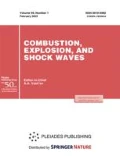Abstract
The protection capability of a flying steel plate against obliquely impacting tungsten heavy alloy long‐rod penetrators was simulated using the NET3D code as a function of plate velocity ranging from −0.5 to 0.5 km/sec at an obliquity of 60°. The negativity in plate velocity was assigned if the plate had a velocity component in the direction of penetrator progress. Based on the residual kinetic energy of the penetrator after perforating the plate, the protection capability of the plate increased as the plate velocity decreased to a negative value at both a normal ordnance velocity (1.5 km/sec) and a hypervelocity (2.5 km/sec) impact. The defeat capability of the oblique plate increased as the impact velocity increased in the plate velocity range studied in this work. The interaction mechanisms between the penetrator and steel plate, responsible for these results, were investigated. The physical meaning of the results obtained in this work were discussed in the light of sensor‐activated and reactive armours.
Similar content being viewed by others
REFERENCES
W. Johnson, A. K. Sengupta, and S. K. Ghosh, “Plasticine modelled high velocity oblique impact and ricochet of long–rods,” Int. J. Mech. Sci., 24, 437–455 (1982).
H. Senf and H. Rothenhausler, “Experimental and numerical investigation of the ricocheting of projectiles from metallic surfaces,” in: Proc. 6th Int. Symp. on Ballistics, Orlando (1981), pp. 549–560.
Z. Rosenberg, Y. Yeshurun, and M. Mayseless, “On the ricochet of long rod projectiles,” in: Proc. 11th Int. Symp. on Ballistics, Brussels, Belgium (1989), pp. 501–506.
L. Holmberg, P. Lundberg, and L. Westerling, “An experimental investigation of WHA long rods penetrating oblique steel plates,” in: Proc. 14th Int. Symp. on Ballistics, Quebec City, Canada (1993), pp. 515–524.
A. C. Charters, T. L. Menna, and A. J. Piekutowski, “Penetration dynamics of rods from direct ballistic tests of advanced armor components at 2–3 km/s,” Int. J. Impact Eng., 10, 93–106 (1990).
D. Yaziv, M. Mayseless, and Y. Reifen, “The penetration process of long rods into thin metallic targets at high obliquity,” in: Proc. 19th Int. Symp. on Ballistics, Interlaken, Switzerland(2001), pp. 1249–1255.
D. J. Gee, “Oblique plate perforation by slender rod projectiles,” ibid., pp. 1123–1132.
D. Yaziv, P. A. Cox, and J. P. Riegel III, “Modified integral theory of impact to model long rod penetration at normal and oblique incidence,” in: S. C. Schimidt, R. D. Dick, and J. W. Forbes (eds.), Shock Compression of Condensed Matter–1991, Elsevier Science Publishers B.V. (1992), pp. 963–966.
R. Jeanquartier and R. Odermatt, “Post–perforation length and velocity of KE projectiles with single oblique targets,” in: Proc. 15th Int. Symp. on Ballistics, Jerusalem, Israel (1995), pp. 245–252.
E. Liden, J. Ottosson, and L. Holmberg, “WHA long rods penetrating stationary and moving oblique steel plates,” in: Proc. 16th Int. Symp. on Ballistics, San Francisco, USA (1996), pp. 711–719.
M. Held, “Disturbance of shaped charge jets by bulging armour,” Propellants, Explos., Pyrotech., 26, 191–195 (2001).
M. Held, M. Mayseless, and E. Rototaev, “Explosive reactive armour,” in: Proc. 17th Int. Symp. on Ballistics, Midrand, South Africa (1998), pp. 33–46.
Y.–H. Yoo, S.–N. Chang, and D.–T. Chung, “Numerical simulation of high–velocity oblique impact of mild steel spheres against mild steel plates,” Trans. KSME, A26, 576–585 (2002).
Y.–H. Yoo and M. Lee, “A three dimensional FE analysis of large deformations for impact loadings using tetrahedral elements,” Comput. Mech., 30, 96–105 (2003).
O. C. Zienkiewicz, J. Rojek, R. L. Taylor, and M. Pastor, “Triangles and tetrahedrals in explicit dynamic codes for solids,” Int. J. Numer. Methods Eng., 43, 565–583 (1998).
C. Hwang, “Three dimensional analysis of dynamic failure in high velocity impact using finite element method,” Ph. D. Thesis, Seoul National University, Seoul, Korea (2002).
G. C. Johnson and D. J. Bammann, “A discussion of stress rates in finite deformation problems,” Int. J. Solids Struct., 20, 725–737 (1984).
L. M. Taylor and D. P. Flanagan, “PRONTO2D, a two–dimensional transient solid dynamic problems,” Report No. SAND86–0594, Sandia National Laboratories, Albuquerque, New Mexico (1987).
M. Oldenburg and L. Nilsson, “The position code algorithm for contact searching,” Int. J. Numer. Methods Eng., 37, 359–386 (1994).
Z. H. Zhong, Finite Element Procedures for Contact–Impact Problems, Oxford Univ. Press, London (1993).
G. R. Johnson and W. H. Cook, “A constitutive model and data for metals subjected to large strains, high strain rates, and high temperatures,” in: Proc. 7th Int. Symp. on Ballistics, The Hague, Netherlands (1983), pp. 541–547.
J. A. Zukas and B. Gaskill, “Ricochet of deforming projectiles,” Int. J. Impact Eng., 18, 601–610 (1996).
A. Tate, “A simple estimate of the minimum target obliquity required for the ricochet of a high speed long rod projectile,” J. Phys. D, Appl. Phys., 12, 1825–1829 (1979).
J. Ottosson, “A numerical study of rear plate effects, and of the influence of projectile strength and geometry for a reactive armour,” FOA Memo 99–5523/S [in Swedish] (1999).
E. Ratner, “Elements for an add–on reactive armour for land vehicles,” U.S. Patent No. 4741244 (1988).
Author information
Authors and Affiliations
Rights and permissions
About this article
Cite this article
Shin, H., Yoo, YH. Effect of the Velocity of a Single Flying Plate on the Protection Capability Against Obliquely Impacting Long‐Rod Penetrators. Combustion, Explosion, and Shock Waves 39, 591–600 (2003). https://doi.org/10.1023/A:1026174121427
Issue Date:
DOI: https://doi.org/10.1023/A:1026174121427




